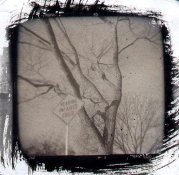Christopher Colley
Member
- Joined
- Jan 24, 2005
- Messages
- 279
- Format
- Multi Format
I have been working with Ziatypes lately and having a great time doing it...though it seems that 1/3 of my prints end up with a random series of black specs on them. It is not the negative, the spots change place each time.. Ive tried using two types of paper, Cranes Platinotype and Fabriano Uno both with a bone dry and quite damp paper/coating and still had the little black dots.
I am wondering if this might be due to air bubbles in the coating? I am using a generic brand x bristle brush of unknown origin and type.
I am using 6 drops each of Ammonium Ferric Oxalate and Lithium Palladium Chloride. Each image is exposed under uv lamps.
anyone have any idea? Ive attached one that doesn't have dots, (ok haven't perfected it yet!) and one that does..
(as an aside I haven't tried it yet, but a drop? of the ammonium dichromate should boost the contrast?)
I am wondering if this might be due to air bubbles in the coating? I am using a generic brand x bristle brush of unknown origin and type.
I am using 6 drops each of Ammonium Ferric Oxalate and Lithium Palladium Chloride. Each image is exposed under uv lamps.
anyone have any idea? Ive attached one that doesn't have dots, (ok haven't perfected it yet!) and one that does..
(as an aside I haven't tried it yet, but a drop? of the ammonium dichromate should boost the contrast?)
Attachments
Last edited by a moderator:













